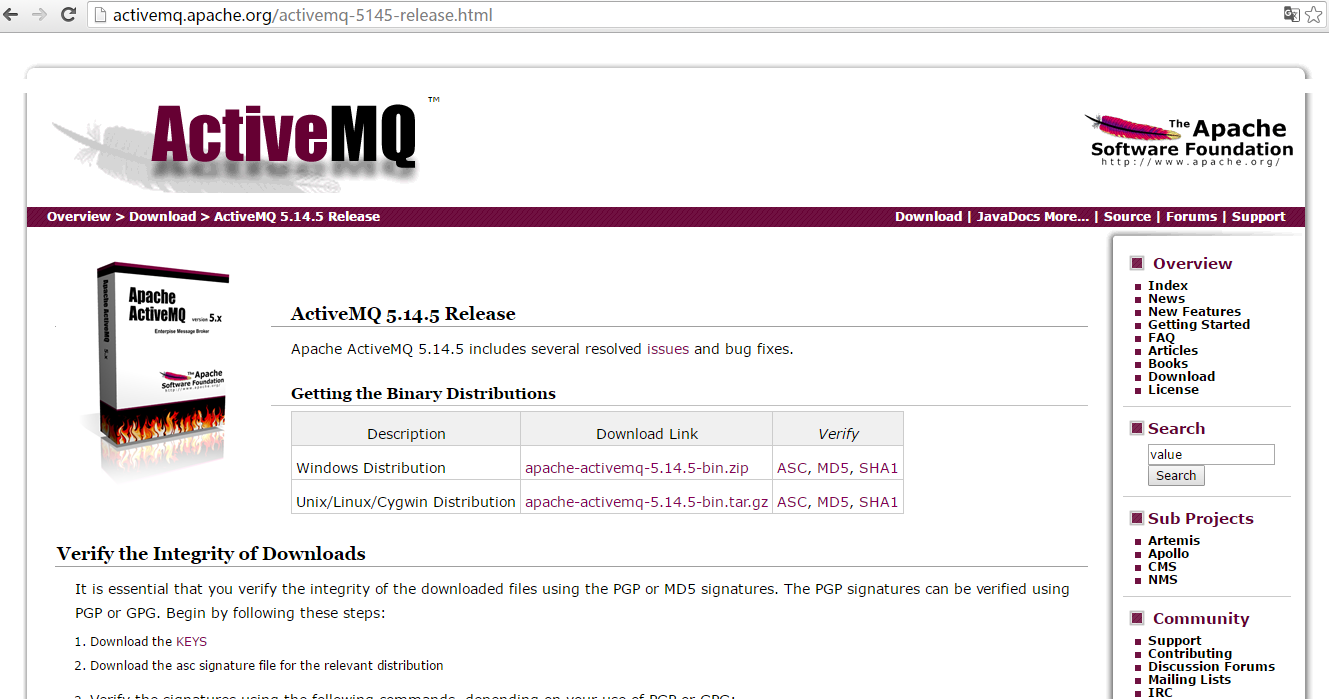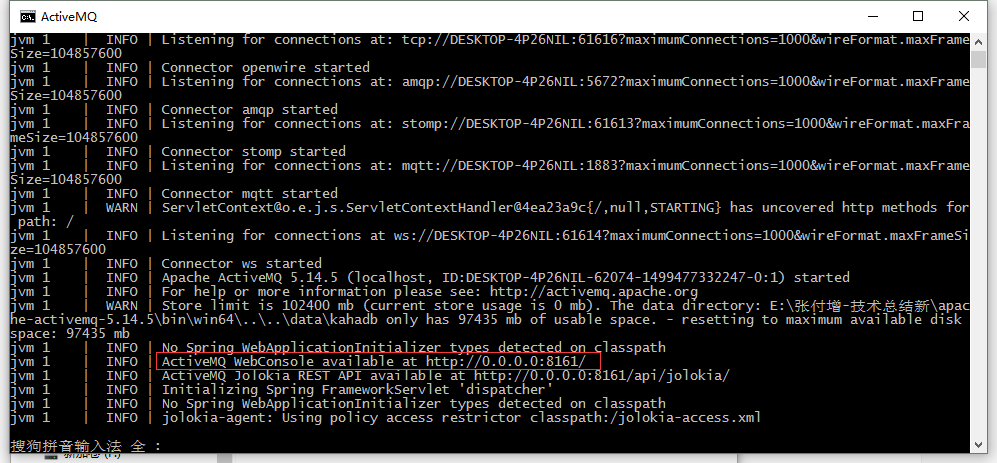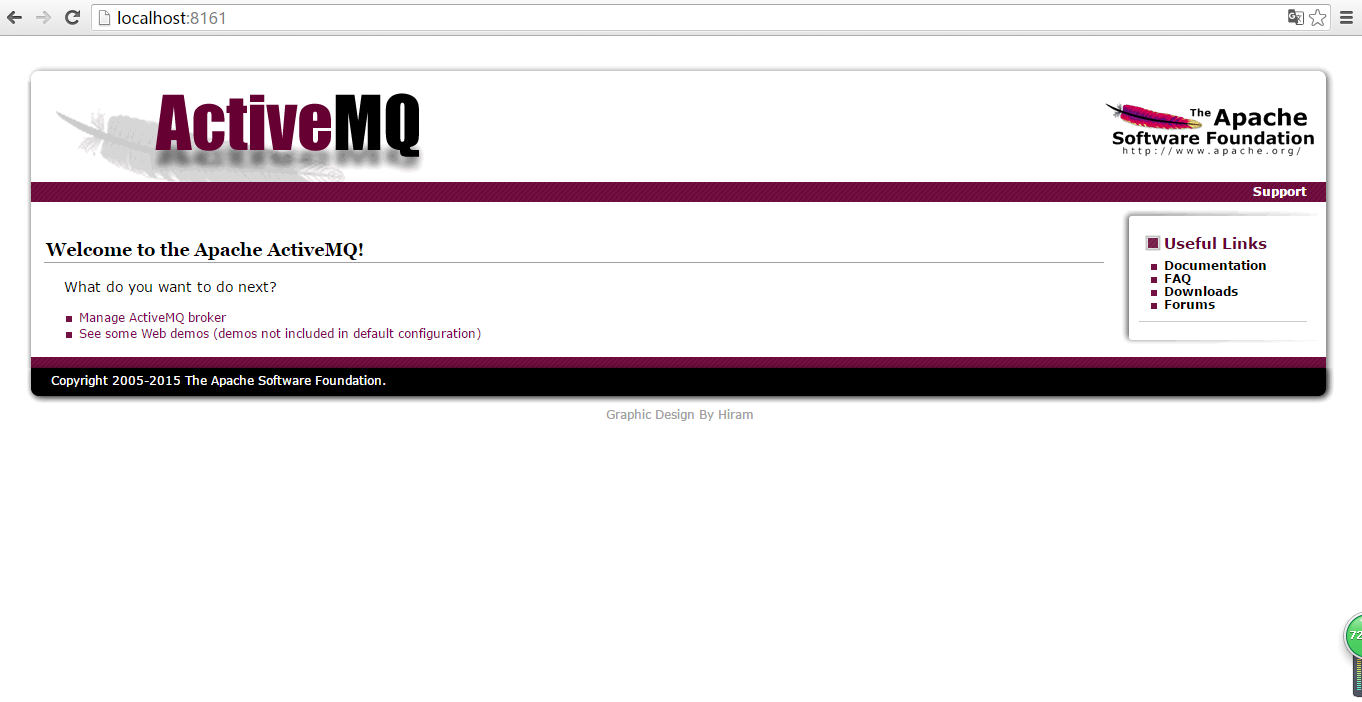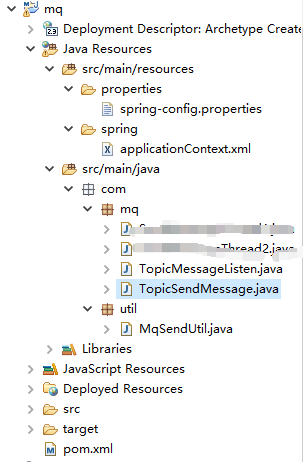版权声明:本文为博主原创文章,未经博主允许不得转载。 https://blog.csdn.net/qq_34988304/article/details/80174725
消息中间件有很多的用途和优点:
1. 将数据从一个应用程序传送到另一个应用程序,或者从软件的一个模块传送到另外一个模块;
2. 负责建立网络通信的通道,进行数据的可靠传送。
3. 保证数据不重发,不丢失
4. 能够实现跨平台操作,能够为不同操作系统上的软件集成技工数据传送服务
MQ
首先简单的介绍一下MQ,MQ英文名MessageQueue,中文名也就是大家用的消息队列,干嘛用的呢,说白了就是一个消息的接受和转发的容器,可用于消息推送。
这里主要介绍一下ActiveMQ
官方网站下载地址: 官方网站下载地址

Windows下下载完直接解压就行,然后到解压的目录,到bin目录下的32或64运行activemq.bat脚本文件。
运行效果图:

启动默认端口号为:8161,在浏览器输入:localhost:8161即可访问如下页面:

这样ActiveMQ安装,启动就完成了。
接下来开始使用ActiveMQ。
项目进本结构:

1.创建一个Maven项目,在pom.xml引入jar包。
<!-- spring-mq包 -->
<dependency>
<groupId>org.springframework</groupId>
<artifactId>spring-webmvc</artifactId>
<version>3.2.8.RELEASE</version>
</dependency>
<dependency>
<groupId>org.apache.activemq</groupId>
<artifactId>activemq-spring</artifactId>
<version>5.14.5</version>
</dependency>
<dependency>
<groupId>org.springframework</groupId>
<artifactId>spring-jms</artifactId>
<version>3.2.8.RELEASE</version>
</dependency>
<!-- json的转换 -->
<dependency>
<groupId>com.alibaba</groupId>
<artifactId>fastjson</artifactId>
<version>1.2.4</version>
</dependency>2.配置mq的链接信息spring-config.properties
这里默认端口号为:61616,账号密码默认为:admin
#mq link Properties
activemq_url=tcp://192.168.1.102:61616
activemq_username=admin
activemq_password=admin3.配置spring+activeMQ的配置文件,这里贴上完成代码,里面有详细注释。
<?xml version="1.0" encoding="UTF-8"?>
<beans xmlns="http://www.springframework.org/schema/beans"
xmlns:xsi="http://www.w3.org/2001/XMLSchema-instance"
xmlns:context="http://www.springframework.org/schema/context"
xmlns:jdbc="http://www.springframework.org/schema/jdbc"
xmlns:jee="http://www.springframework.org/schema/jee"
xmlns:tx="http://www.springframework.org/schema/tx"
xmlns:aop="http://www.springframework.org/schema/aop"
xmlns:mvc="http://www.springframework.org/schema/mvc"
xmlns:util="http://www.springframework.org/schema/util"
xmlns:jpa="http://www.springframework.org/schema/data/jpa"
xmlns:amq="http://activemq.apache.org/schema/core"
xmlns:jms="http://www.springframework.org/schema/jms"
xsi:schemaLocation="
http://www.springframework.org/schema/beans http://www.springframework.org/schema/beans/spring-beans-3.2.xsd
http://www.springframework.org/schema/context http://www.springframework.org/schema/context/spring-context-3.2.xsd
http://www.springframework.org/schema/jdbc http://www.springframework.org/schema/jdbc/spring-jdbc-3.2.xsd
http://www.springframework.org/schema/jee http://www.springframework.org/schema/jee/spring-jee-3.2.xsd
http://www.springframework.org/schema/tx http://www.springframework.org/schema/tx/spring-tx-3.2.xsd
http://www.springframework.org/schema/data/jpa http://www.springframework.org/schema/data/jpa/spring-jpa-1.3.xsd
http://www.springframework.org/schema/aop http://www.springframework.org/schema/aop/spring-aop-3.2.xsd
http://www.springframework.org/schema/mvc http://www.springframework.org/schema/mvc/spring-mvc-3.2.xsd
http://www.springframework.org/schema/util http://www.springframework.org/schema/util/spring-util-3.2.xsd
http://www.springframework.org/schema/jms http://www.springframework.org/schema/jms/spring-jms-4.0.xsd
http://activemq.apache.org/schema/core http://activemq.apache.org/schema/core/activemq-core-5.14.5.xsd
">
<context:annotation-config/>
<context:component-scan base-package="com"/>
<!-- 读取配置文件 -->
<bean id="propertyPlaceholderConfigurer" class="org.springframework.beans.factory.config.PropertyPlaceholderConfigurer">
<property name="locations">
<array>
<value>classpath:properties/spring-config.properties</value>
</array>
</property>
</bean>
<!-- ActiveMQ 连接工厂 -->
<!-- 真正可以产生Connection的ConnectionFactory,由对应的 JMS服务厂商提供-->
<!-- 如果连接网络:tcp://ip:61616;未连接网络:tcp://localhost:61616 以及用户名,密码-->
<amq:connectionFactory id="amqConnectionFactory" brokerURL="${activemq_url}" userName="${activemq_username}" password="${activemq_password}"/>
<!-- 这里可以采用连接池的方式连接PooledConnectionFactoryBean -->
<bean id="connectionFactory" class="org.springframework.jms.connection.CachingConnectionFactory">
<!-- 配置连接 -->
<property name="targetConnectionFactory" ref="amqConnectionFactory"/>
<!-- 会话的最大连接数 -->
<property name="sessionCacheSize" value="100"/>
</bean>
<!-- 定义消息队列topic类型,queue的方式差不多 -->
<bean id="topic" class="org.apache.activemq.command.ActiveMQTopic">
<!-- 定义名称 -->
<constructor-arg index="0" value="topic"/>
</bean>
<!-- 配置JMS模板(topic),Spring提供的JMS工具类,它发送、接收消息。 -->
<!-- 为了测试发送消息,保留jmsTemplate的配置,实际不存在发送,只需要配置监听即可 -->
<bean id="jmsTopicTemplate" class="org.springframework.jms.core.JmsTemplate">
<property name="connectionFactory" ref="connectionFactory"/>
<property name="defaultDestination" ref="topic"/>
<!-- 非pub/sub模型(发布/订阅),true为topic,false为queue -->
<property name="pubSubDomain" value="true"/>
</bean>
<!-- 定义JmsTemplate的Queue类型 -->
<bean id="jmsQueueTemplate" class="org.springframework.jms.core.JmsTemplate">
<!-- 这个connectionFactory对应的是我们定义的Spring提供的那个ConnectionFactory对象 -->
<constructor-arg ref="connectionFactory" />
<!-- 非pub/sub模型(发布/订阅),即队列模式 -->
<property name="pubSubDomain" value="false" />
</bean>
<!-- 监听方式,这种方式更实用,可以一直监听消息 -->
<bean id="topicMessageListen" class="com.mq.TopicMessageListen"/>
<bean id="defaultMessageListenerContainer" class="org.springframework.jms.listener.DefaultMessageListenerContainer">
<property name="connectionFactory" ref="connectionFactory"/>
<!-- 注册activemq名称 -->
<property name="destination" ref="topic"/>
<property name="messageListener" ref="topicMessageListen"/>
</bean>
</beans>4.配置好了,接下来就写实现
创建一个MqSendUtil.java的通用发送方法。
package com.util;
import javax.jms.JMSException;
import javax.jms.Message;
import javax.jms.Session;
import javax.jms.TextMessage;
import org.apache.xbean.spring.context.ClassPathXmlApplicationContext;
import org.springframework.context.ApplicationContext;
import org.springframework.jms.core.JmsTemplate;
import org.springframework.jms.core.MessageCreator;
public class MqSendUtil {
private ApplicationContext ac = new ClassPathXmlApplicationContext("classpath:spring/applicationContext.xml");
private JmsTemplate jmsTemplate = (JmsTemplate) ac.getBean("jmsTopicTemplate");
public void send(final String message){
jmsTemplate.send(new MessageCreator() {
public Message createMessage(Session session) throws JMSException {
TextMessage msg = session.createTextMessage();
msg.setText(message);
System.out.println("发送数据++++++++++++发送数据:"+message);
return msg;
}
});
}
}
监听发送的消息TopicMessageListen.java
package com.mq;
import java.util.Map;
import javax.jms.Message;
import javax.jms.MessageListener;
import javax.jms.TextMessage;
import com.alibaba.fastjson.JSON;
public class TopicMessageListen implements MessageListener{
//监听接口获取数据
public void onMessage(Message message) {
try {
System.out.println("------------获取到的数据:"+message);
TextMessage tm = (TextMessage)(message);
String aa = tm.getText();
Map<String, Object> map = JSON.parseObject(aa);
System.out.println("------------------aa的值:"+map.get("aa"));
System.out.println("------------------bb的值:"+map.get("bb"));
//在这里可以进行操作。
} catch (Exception e) {
e.printStackTrace();
}
}
}调用发送util实现发送TopicSendMessage.java
package com.mq;
import java.util.HashMap;
import java.util.Map;
import com.alibaba.fastjson.JSON;
import com.util.MqSendUtil;
public class TopicSendMessage {
public static void main(String[] args) {
MqSendUtil mq = new MqSendUtil();
Map<String, Object> map = new HashMap<String, Object>();
map.put("aa", "Thread2 aa的值");
map.put("bb", "Thread2 bb的值");
mq.send(JSON.toJSONString(map));
System.out.println("Thread2 请求的数据:"+map);
}
}运行图:
